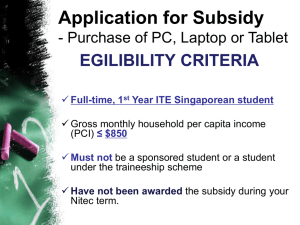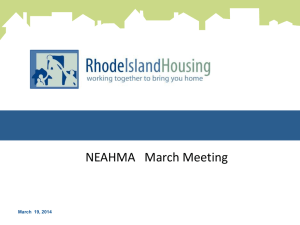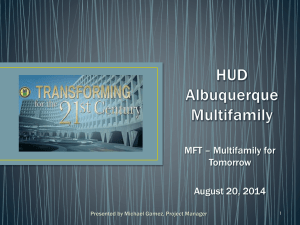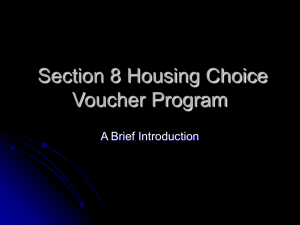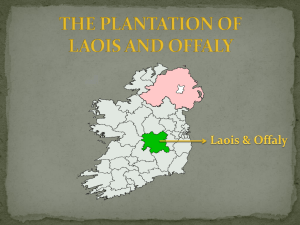TRACS 202D Washington AHMA - Affordable Housing Management
advertisement
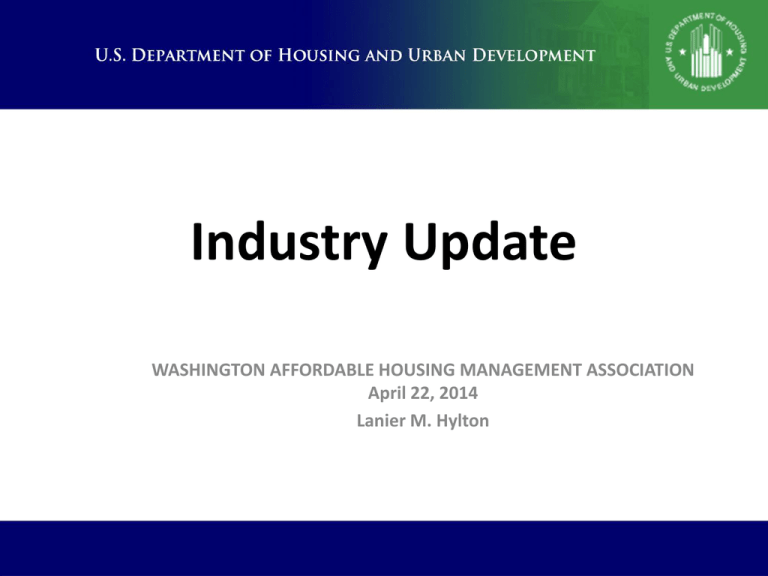
Industry Update WASHINGTON AFFORDABLE HOUSING MANAGEMENT ASSOCIATION April 22, 2014 Lanier M. Hylton Overview • 202D Spec Status • Spec changes since the March Industry Meeting • Chapter 4 items worth reviewing • Multifamily Housing Help Desk Update • iSERS • Low Income Housing Tax Credit • Next TRACS Industry Meeting Dates 2 202D Release Dates • May 2014 – HUD Forms Approved by OMB • July 1, 2014 – Go live • January 1, 2014 – Final Implementation Deadline 3 New, New, New New Forms • New 50059 • New Forms • New 50059A • New Special Claims Forms • New Voucher Forms New Errors • Current project • Working on modifying all error codes • Eliminate outdated codes • Eliminate unnecessary codes • Re-word 4 202D Spec Status • • • • Originally published at the end of July, 2011. Last update January 31, 2014 One more update to add TIN Regular working group conference calls to deal with clarifications and new and modified HUD requirements 5 New Subsidy Type = PRAD • • • • • Project Rental Assistance Demonstration. Like an 811 PRAC. Block grant to the states. State decides % of income paid up to 50%. MAT Header Records – Subsidy Type = 6 (previously reserved). • Use Rent Override flag to indicate non-30% rent calculation. 6 New Subsidy Type = RAD • Rental Assistance Demonstration (PIH-2012-18 (HA). • Conversion of PIH Vouchers, PIH S8 Sub Rehab, Rent Supplement and RAP to MF Project Based S8. • If tenant’s current rent is lower than that calculated by the S8 formula, there is a 3-5 year phase in to full rent—similar concept to the old POA rollout. • Subsidy Type Project-based Section 8 in MAT header. • Use the rent override flag to indicate non-30% rent calculation. 7 RAD Rent Phase-In • Phase-in of Tenant Rent Increases. If a tenant’s monthly rent increases by more than the greater of 10 percent or $25 purely as a result of conversion, the rent increase will be phased in over 3 years, which a PHA may extend to 5 years with goodcause.15 To implement this provision, HUD is waiving section 3(a)(1) of the Act, as well as 24 CFR §§ 983.3 (definition of “total tenant payment”) and 983.353(b)(1), to the limited extent necessary to allow for the phase-in of tenant rent increases. 8 New Subsidy Type = SPRAC • Senior Preservation Rental Assistance Contracts. • Program for the Elderly. • To provide rental assistance for unassisted seniors who would be displaced by a rehab and refinancing. • New Subsidy Type in MAT header? • The cert calculation rules are unclear. 9 Number Expansion DUNS Number • DUNS Numbers will be required for Rent Supplement and RAP in the near future. • Currently required for Section 8 and 202 and 811 PRAC. TIN • Field offices have asked for edit • Collect TIN for Parent and Child • Field included in Header Record but not on forms • Similar to DUNS 10 MAT15 Tax Credit BINs • Clarification added about the format expected for a BIN. • Note: Do not fill the field unless there is a valid BIN associated with it. A valid BIN is in the format SSYYNNNNN where SS is the state postal abbreviation, YY is the last two digits of the allocation year and NNNNN is 5 digits. YY can be in the range 85-99 and 00-12 with 13 becoming valid in 2013 and so forth. If YY is either 19 or 20, the BIN is not valid. 11 Repayment Agreements • Chapter 4, paragraph 4.9. • The implementation of TRACS Release 2.0.2.D will allow for improved tracking and reporting, repayment agreements will no longer be reported as miscellaneous accounting request transactions. 12 Repayment Agreement Record • New MAT30, Section 7 record. • Requires a new MAT30, Section 1 Section 7 Count field. • Requires a new MAT30, Section 2, field 28 and 43 to hold site Section 7 totals and CA Section 7 payment amounts. • Revised and renamed spreadsheet: 202DCalculationsForRepayments.xlsx 13 Selected Section 7 Record Fields • HOH Name and Unit Number. • Agreement ID. – Generated by Owner/Agent. – 12 characters; unique within the project. • Effective Date (of the original agreement). • Agreement Amount = original amount. • MAT30 Section 7 record MAT Field #9 Agreement Type contains the following valid field types: – T = Tenant Repayment Agreement transaction. – O = Owner/Agent Repayment Agreement transaction. – N = None or No Agreement. Print on the form as Tenant, Owner or None. 14 Section 7 Fields (cont.) • Total Payment = payment from the OA or tenant. • Amount Retained = type T subject to 20% rule: lesser of actual expenses or 20% of payment. • Ending Balance = agreement balance after the transaction. • Amount Requested = the amount of the Section 7 transaction. 15 Expansion of Move-Out Codes In keeping with the effort to enable OAs to more fully document information pertinent to the move-out transaction, seven new codes have been added to more closely track the reason for a move-out. 5 = Unit Transfer between two projects. 7 = Abandoned Unit 8 = Failure to submit SSN 9 = Uninhabitable unit (Abated) 10 = Substantial Rehab or Repair (Tenant Expected to Return) 11 = Choice-Mobility Option Exercised – Tenant moved from RAD subsidy to HCV Description field has also been added to hold the text that describes the reason for the move-out. 16 Termination Codes/Descriptions Add a new reference table to contain all termination codes/descriptions (10 existing plus new codes). New termination codes are: • ND = Natural Disaster or Uninhabitable Unit or Presidentially Declared Disaster • AB = HUD abated unit • RR = Substantial rehab or repair (Tenant expected to return) • NS = Resident did not qualify for subsidy at MI or IC for a reason other than Double Subsidy. • Typically, this would be a situation where income at MI or IC is being corrected as a result of an EIV or other investigation and it is found that the tenant was not eligible. (Just like the DS code, a TM/NS gives back subsidy for the TM date). • OT = Other. A reason not covered by any of the other codes. • Field 12, Description must be filled 17 Previous Housing Code • To facilitate the capture of data on whether or not a family was homeless prior to admission to a multifamily property, two (2) new codes have been added to the existing four codes for the MAT10, Section 2 Previous Housing Code field. The new codes are as follows: 5 = Lacking a fixed Nighttime Residence 6 = Fleeing/Attempting to Flee Violence • The existing code value 2 (Without or Soon to be Without Housing) has been redefined as applicable only to records transmitted in TRACS 2.0.2.C or as corrections to MI certifications originally transmitted in TRACS 2.0.2.C. 18 MAT30 Changes • Field widths for the Section 5 and Section 6 Paid amounts have been widened to 10 characters to match the Claim Amount and Misc Request Amount fields. • New Misc Request Codes. – EIVP = EIV 5% penalty. – RESR = Residual Receipts offset. See Notice H 2012-14 for instructions pertaining to the use of residual receipts in this context. • Deleted Misc Request Codes—covered by the new Section 7 record. – REPA – RTNA 19 Integrated Subsidy Error Reduction System • The Integrated Subsidy Error Reduction System (iSERS), formally know as the Error Tracking Log will establish whether and to what extend owners are accurately, thoroughly and clearly determining family income and rent in the Multifamily Housing Subsidy programs. • The initiative objectives are: – Detect and reduce errors in income and rent calculations at targeted owners – Reduce rent underpayments and/or overpayments of residents – Maximize HUD’s limited housing resources thereby assuring maximum participation in HUD’s housing programs by as many low families as feasible. 20 Integrated Subsidy Error Reduction System • There are three process areas designated as “discovery points” during which errors made by owner/agents (OA) that may cause improper subsidy payment: – – – – Certification/Voucher Review Management and Occupancy Review (MOR) Resident Contact (RC) EIV Discovery? 21 Integrated Subsidy Error Reduction System • The 2001 Policy Development and Research (PD&R) Quality Control for Rental Assistance Subsidies Determinations study (QC study), found that 60 percent of all rent and subsidy calculations contained some type of error. • The most common sources of errors are: – – – – Calculation errors Failure to verify income/expenses Failure to use UIV tools & techniques Incorrect income and deduction amounts (i.e., earned income, pension income, and medical allowances) 22 Low Income Housing Tax Credit • LIHTC will integrate technology to coordinate the assessment and discovery of data quality issues, the definition of data quality rules, the use of those rules for distinguishing between valid and invalid data and the management, measurement, and reporting of conformance to established data quality rules. • This LIHTC initiative will identify which data to produce metrics on and define which of the many aspects of its quality to measure. These data quality dimensions will include: • • 23 Low Income Housing Tax Credit • Structure: Is the data in the right format and values ensures is consisted of part of the criteria for data quality measures (is the data usable)? • Conformity: Does it conform to critical rules? • Accuracy: Does it reflect the real world? • Completeness: Is the mandatory data/information present? • Timeliness: Is it sufficiently current based upon the mandatory reporting timeframes? • Uniqueness: Are there duplicate records creating confusion? • Consistency: Is the data the same, regardless of where it resides? • Relevance: Is it useful to HUD’s pursuit of objectives for Congressional reporting? 24 Multifamily Housing Help Desk Total Tickets Created = 9,782 BY CATEGORY • Majority (6,074) of tickets created addressed Functional Issues • Next highest (788) tickets created addressed Tenant and Voucher Error Resolutions Issues • The third highest (777) tickets created addressed Secure Systems Issues • Remaining tickets spread randomly among other issues BY SYSTEM • Majority (5671) of tickets created were for concerns related to the EIV system • Next highest (2462) of tickets created were for concerns related to the Tracs system • Third highest (910) tickets created were for concerns related to the Apps system • Remaining tickets spread randomly among the other systems 25 Multifamily Housing Help Desk Technical Progress • As of 04/15/2014 no back log existed in the cases that are handled MFH Help Desk • Help Desk staff consistently meets and/or exceeds the established SLA for calls: – 99% of requests are answered on the caller’s first attempt – Calls are answered within 30 seconds or caller can leave a voice message if he/she chooses; call returned within the first hour of receipt—within same or next business day – 90% of all requests received are resolved or referred within 1-3 business days – Received on average 8 complaints within any given month regarding courtesy, service, and/or lost/late messages • Survey for user response set to be updated and rolled out in 2nd quarter of 2013 to address client complaints. • Quality Control Analyst and Program Manager are working effectively to ensure that all calls are handled timely and accurately. Calls (recorded and live) are monitored daily. 26 Multifamily Housing Help Desk SUMMARY • net.America’s Help Desk support services continues to grow and develop, creating a staff with an average tenure of 2 ½ years for the 6 systems. Average IT Help Desk experience for the staff is 5 years. The staff is more than capable of providing all of the services required and the results of their efforts are reflect in the lack of backlog (most cases are resolved with the same day) and in their knowledge base. 27 Posted Docs • Spec posted on 202D discussion forum • TRACS Industry Working Group Meeting October 29th and 30th 2014 • HUD Discussion Forums • http://ptp.hud.gov/forumswww/main.cfm?CF App=13 28 Thank You! • Lanier Hylton Lanier.M.Hylton@hud.gov – All Round Great Guy!! • Jed Graef jed.graef@mrisoftware.com – 202D Specification Documentation • Mary Ross mary.ross@rbdnow.com – TRACS Error Messages 29
